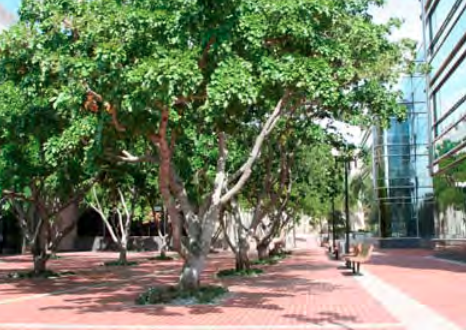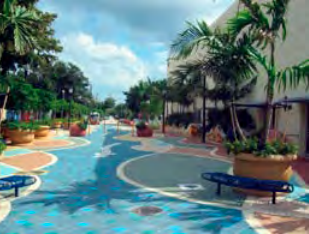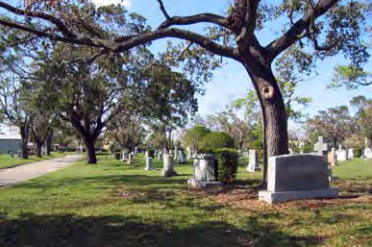Miami Parks and Public Spaces Master Plan
|
The system of public spaces and parks is relatively small for a city of such a great population. The original concept of connected parks from neighborhood to neighborhood that was in place since the start of the city has been proven to be beneficial when done correctly, but the low number of parks does not allow the system to function properly. The connections between the parks are much too far apart to operate together in a physical system. The city currently faces issues with wanting to focus on and develop more of its signature bay front parks but feels the need to focus more of its attention on families in less affluent parts of Miami. [1]
Although the number of parks is not at its optimum number, the city still tries to emphasize accessibility. The two key aspects to access is location and ease of mobility to the park, through safer streets for walking and biking and more accessible modes of transit. Of even greater importance is accessibility of parks for children and seniors specifically. Children use parks for organized sports and active pastime and seniors are able to maintain health through healthy exercising and recreation. Also, they demand a higher standard of safety en route to these parks. [1] |
|
Aside from recreational parks, the city also has a number of open areas for public use, like plazas. There are zoning ordinances along some streets in Miami that require an area of public access. For example, code 5.8.1 in the Miami 21 Zoning Ordinance says that buildings in zone CI-HD must have a public plaza and walkways to provide pedestrians a way between two parallel public streets. In downtown, there are many private business buildings and institutions that, by the zoning ordinance, must have a public plaza or widened sidewalks for the public. Figure 1 shows a private building on Brickell Avenue that has a large area for public use. These plazas downtown often are used as rest or lunchtime places for workers or any pedestrians. With proper planning of these spaces, being safe, visually appealing, and well designed, they become a popular attraction to those walking by and working in the area. Some of these plazas may be much bigger, running between buildings, serving as a public leisure areas and a connection between different areas of the city. Figure 2 shows the Latin Quarter Plaza, a large public area connecting neighborhoods to other parks. [1] [2]
|
In planning for the future of parks and public spaces, the plan focuses on nine specific key points [1]:
- Balancing Acreage and Access
- Preserving and Enhancing Existing Parks and Open Spaces
|
- Making Access Real Through Strong Connections
- Make Miami’s Park System the Country’s Greenest and Most Sustainable
- Every Park System Needs Many Friends
- Improving Management and Operations
- Diversifying Funding for Capital Operations and Program Improvements
Sources:
[1] The City of Miami Parks & Recreation Department and Planning Department. Miami Parks and Public Spaces Master Plan. http://www.miamigov.com/planning/docs/plans/MP/Parks_Master_Plan.pdf. May 2007.
[2] http://www.miami21.org/PDFs/May2015-VolumeI.pdf
Images:
Figure 1: The City of Miami Parks & Recreation Department and Planning Department. Miami Parks and Public Spaces Master Plan. pg. 41. http://www.miamigov.com/planning/docs/plans/MP/Parks_Master_Plan.pdf. May 2007.
Figure 2: The City of Miami Parks & Recreation Department and Planning Department. Miami Parks and Public Spaces Master Plan. pg. 42. http://www.miamigov.com/planning/docs/plans/MP/Parks_Master_Plan.pdf. May 2007.
Figure 3: The City of Miami Parks & Recreation Department and Planning Department. Miami Parks and Public Spaces Master Plan. pg. 71. http://www.miamigov.com/planning/docs/plans/MP/Parks_Master_Plan.pdf. May 2007.
[1] The City of Miami Parks & Recreation Department and Planning Department. Miami Parks and Public Spaces Master Plan. http://www.miamigov.com/planning/docs/plans/MP/Parks_Master_Plan.pdf. May 2007.
[2] http://www.miami21.org/PDFs/May2015-VolumeI.pdf
Images:
Figure 1: The City of Miami Parks & Recreation Department and Planning Department. Miami Parks and Public Spaces Master Plan. pg. 41. http://www.miamigov.com/planning/docs/plans/MP/Parks_Master_Plan.pdf. May 2007.
Figure 2: The City of Miami Parks & Recreation Department and Planning Department. Miami Parks and Public Spaces Master Plan. pg. 42. http://www.miamigov.com/planning/docs/plans/MP/Parks_Master_Plan.pdf. May 2007.
Figure 3: The City of Miami Parks & Recreation Department and Planning Department. Miami Parks and Public Spaces Master Plan. pg. 71. http://www.miamigov.com/planning/docs/plans/MP/Parks_Master_Plan.pdf. May 2007.



